Pilot-Scale Experimental Study on Impacts of Biomass Cofiring Methods to NOx Emission from Pulverized Coal Boilers—Part 2: NOx Reduction Capability through Reburning versus Cofiring
Abstract
:1. Introduction
2. Experimental Setup and Conditions
3. Results and Discussion
3.1. Carbon Conversion of the Reburning versus Cofiring
3.2. NOx Reduction Behavior of Reburning versus Cofiring
3.3. NOx Reduction Effectiveness of Reburning versus Cofiring
4. Conclusions
- Reburning leads to significantly higher NOx reduction than cofiring. The NOx reduction effectiveness of reburning technology can be 3.4 times higher than the NOx reduction effectiveness of cofiring technology, depending on the biomass fuel characteristics. The NOx reduction effectives in reburning technology can be as high as 4.9.
- NOx reduction effectiveness reduces exponentially as the reburning ratio increases. Therefore, continuous low reburning ratios are more cost-efficient than periodic high reburning ratios.
- For WP and EFB, reburning leads to lower fuel conversion than cofiring cases, which is the drawback of using reburning technology for NOx reduction compared to cofiring technology.
- With the large residence time applied in this study, NOx reduction in reburning technology depends less on fuel properties, such as fuel ratio or amount of fuel-inherited nitrogen. It is observed that the three biomasses with different fuel characteristics led to quite similar NOx reduction through reburning technology. This is in opposition with the cofiring technology, which highly depends on fuel characteristics, and especially the amount of volatile matter.
Author Contributions
Funding
Institutional Review Board Statement
Informed Consent Statement
Acknowledgments
Conflicts of Interest
References
- Baxter, L.L.; Mitchell, R.E.; Fletcher, T.H.; Hurt, R.H. Nitrogen release during coal combustion. Energy Fuels 1996, 10, 188–196. [Google Scholar] [CrossRef] [Green Version]
- Albrecht, W. NOx emissions from pulverised coal flames. Vgb Kraftw. Engl. Issue 1993, 72, 564–571. [Google Scholar]
- Reidick, H.; Kessel, W.; Fritz, P.; Hein, K. In-furnace NOx reduction of selected brown coal-fired steam generators. Vgb Kraftw. Engl. Issue 1991, 71, 400–404. [Google Scholar]
- Nussbaumer, T. Wood combustion. In Advances in Thermochemical Biomass Conversion; Blackie Academic & Professional: London, UK, 1994; ISBN 07514 01714. pp. 575–589. [Google Scholar]
- Nussbaumer, T. Combustion and co-combustion of biomass: Fundamentals, technologies and primary measures for emission reduction. Energy Fuel 2003, 17, 1510–1521. [Google Scholar] [CrossRef]
- Pershing, D.W.; Wendt, J.O.L. Relative contributions of volatile nitrogen and char nitrogen to NOx emissions from pulverised coal flames. Industrial and Engineering Chemistry Process. Des. Dev. 1979, 18, 60–66. [Google Scholar]
- Aarna, I.; Suuberg, E.M. A review of the kinetics of the nitric oxide-carbon reaction. Fuel 1997, 76, 475–491. [Google Scholar] [CrossRef]
- Cahill, P.; Smith, M.; Vallender, S.J. Characterisation of British coals for low NOx combustion. In Proceedings of the 1991 International Conference on Coal Science, Newcastle-upon-Tyne, UK, 16–20 September 1991. [Google Scholar]
- Reed, R.D. Process for the disposal of nitrogen oxide. John Zink Company, US Patent 1,274,637, 1969. [Google Scholar]
- Wendt, J.O.L.; Sternling, C.V.; Matovich, M.A. Reduction of Sulfur Trioxide and Nitrogen Oxides by Secondary Fuel Injection; 14th International Symposium on Combustion; The Combustion Institute: Pittsburgh, PA, USA, 1973. [Google Scholar]
- Myerson, A.L.; Taylor, F.R.; Faunce, B.G. Ignition Limits and Products of the Multistage Flames of Propane-Nitrogen Dioxide Mixtures; 6th International Symposium on Combustion; The Combustion Institute: Pittsburgh, PA, USA, 1957. [Google Scholar]
- Harding, N.S.; Adams, B.R. Biomass as a reburning fuel: A specialized co-firing application. Biomass Bioenergy 2000, 19, 429–445. [Google Scholar] [CrossRef]
- Lewis, R.D. Three-Stage Combustion (Reburning) Test Results From a 300-MW Boiler in the Ukraine. In Proceedings of the 1993 Joint Symposium on Stationary Combustion NOx Control, Miami Beach, FL, USA., 24–27 May 1993. [Google Scholar]
- Seu, S.W.H.; Castaldini, C.; Neuffer, W.J.; Durkee, K.R. Retrofit NOx Controls for Existing Industrial, Commercial, and Institutional Boilers: Status of Technologies and Cost Effectiveness. In Proceedings of the 1993 Joint Symposium on Stationary Combustion NOx Control, Miami Beach, FL, USA, 24–27 May 1993. [Google Scholar]
- Okigami, N.; SekiGuchi, Y.; Miura, Y.; Sasaki, K.; Tamura, R. Three Stage Pulverized Coal Combustion System for In-furnace NOx Control. In Proceedings of the 1985 Joint Symposium on Stationary Combustion NOx Control, Boston, MA, USA, 6 May 1986. [Google Scholar]
- Chen, S.L.; McCarthy, J.M.; Clark, W.D.; Heap, M.P.; Seeker, W.R.; Pershing, D.W. Bench and Pilot Scale Process Evaluation of Reburning for In-furnace NOx Reduction. In Proceedings of the 21st International Symposium on Combustion, Pittsburgh, PA, USA, 3–8 August 1986. [Google Scholar]
- Adams, B.R.; Harding, N.S. Reburning using biomass for NOx control. Fuel Process. Technol. 1998, 54, 249–263. [Google Scholar] [CrossRef]
- Ma, J.; Shen, J.; Liu, J.; Ma, Y.; Jiang, X. Reburning study of superfine pulverized coal in high CO2 concentration. Fuel 2018, 220, 25–31. [Google Scholar] [CrossRef]
- Furusawa, T.; Tsunoda, M.; Tsujimura, M.; Adschiri, T. Nitric oxide reduction by char and carbon monoxide: Fundamental kinetics of nitric oxide reduction in fluidized bed combustion of coal. Fuel 1985, 64, 1306–1309. [Google Scholar] [CrossRef]
- Ballester, J.; Ichaso, R.; Pina, A.; Gonzalez, M.A.; Jimenez, S. Experimental evaluation and detailed characterization of biomass reburning. Biomass Bioenergy 2008, 32, 959–970. [Google Scholar] [CrossRef]
- Maly, P.M.; Zamansky, V.M.; Ho, L.; Payne, R. Alternative fuel reburning. Fuel 1999, 78, 327–334. [Google Scholar] [CrossRef]
- Rudiger, H.; Kicherer, A.; Greul, U.; Spliethoff, H.; Hein, K.R.G. Investigations in combined combustion of biomass and coal in power plant technology. Energy Fuels 1996, 10, 789–796. [Google Scholar] [CrossRef]
- Lopez, C.; Maier, J.; Hein, K.R.G. NOx Reduction by Solid Fuel Reburning: Pilot Scale Investigations; IEA Conference: Clean Coal Technologies for Our Future; IEA Clean Coal Center: London, UK, 2002. [Google Scholar]
- Casaca, C.; Costa, M. NOx control through reburning using biomass in a laboratory furnace: Effect of particle size. Proc. Combust. Inst. 2009, 32, 2641–2648. [Google Scholar] [CrossRef]
- Vilas, E.; Skifter, U.; Jensen, A.D.; Lopez, C.; Maier, J.; Glarborg, P. Experimental and modeling study of biomass reburning. Energy Fuels 2004, 18, 1442–1450. [Google Scholar] [CrossRef]
- Shu, Y.; Wang, H.; Zhu, J.; Tian, G.; Huang, J.; Zhang, F. An experimental study of heterogeneous NO reduction by biomass reburning. Fuel Process. Technol. 2015, 132, 111–117. [Google Scholar] [CrossRef]
- Hodzic, N.; Kazagic, A.; Smajevic, I. Influence of multiple air staging and reburning on NOx emissions during co-firing of low rank brown coal with woody biomass and natural gas. Appl. Energy 2016, 168, 38–47. [Google Scholar] [CrossRef]
- Lu, P.; Wang, Y.; Huang, Z.; Lu, F.; Liu, Y. Study on NO reduction and its heterogeneous mechanism through biomass reburning in an entrained flow reactor. Energy Fuels 2011, 25, 2956–2962. [Google Scholar] [CrossRef]
- Zhou, W.; Swanson, L.; Moyeda, D.; Xu, G. Process evaluation of biomass co-firing and reburning in utility boilers. Energy Fuels 2010, 24, 4510–4517. [Google Scholar] [CrossRef]
- Brouwer, J.; Heap, M.P.; Bales, F.E.; Brouwer, J.; Heap, M.P.; Bales, F.E. The Use of Wood as a Reburning Fuel in Combustion Systems. In Proceedings of the 6th national bioenergy conference, Reno, NV, USA, 2–6 October 1994. [Google Scholar]
- Spliethoff, H.; Gruel, U.; Rüdiger, H.; Hein, K.R.G. Basic effects on NOx emissions in air staging and reburning at a bench-scale test facility. Fuel 1996, 75, 560–564. [Google Scholar] [CrossRef]


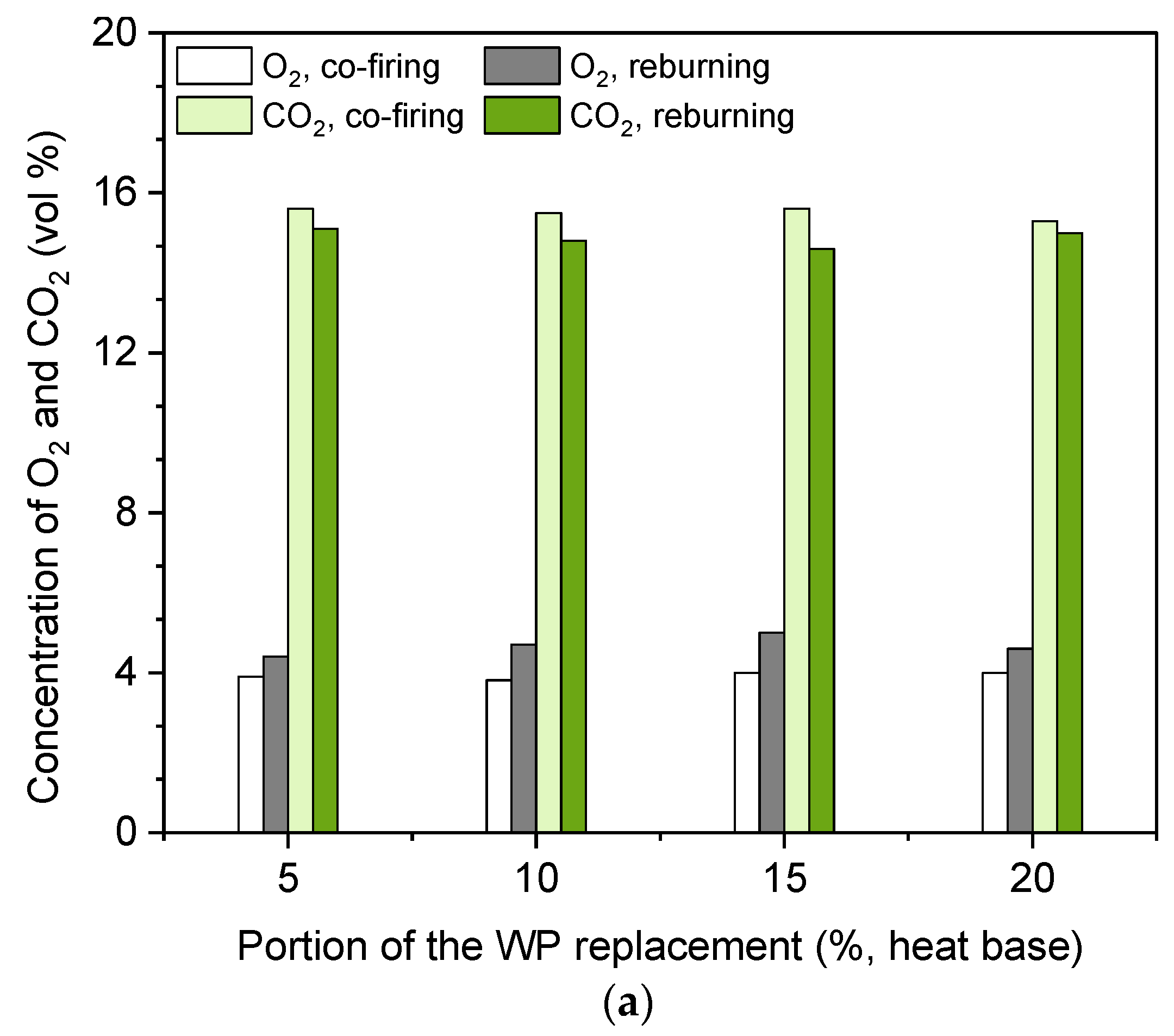
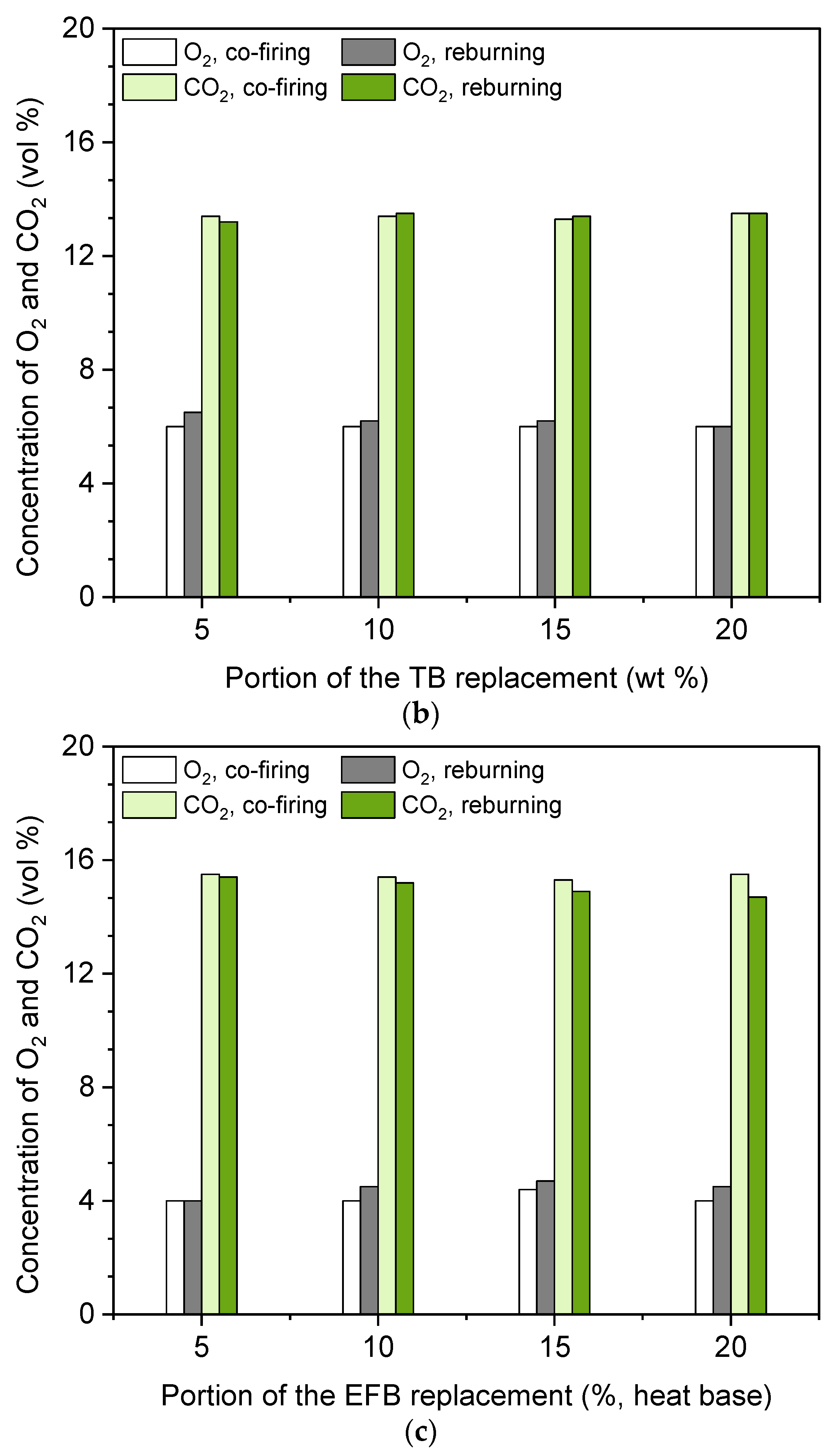
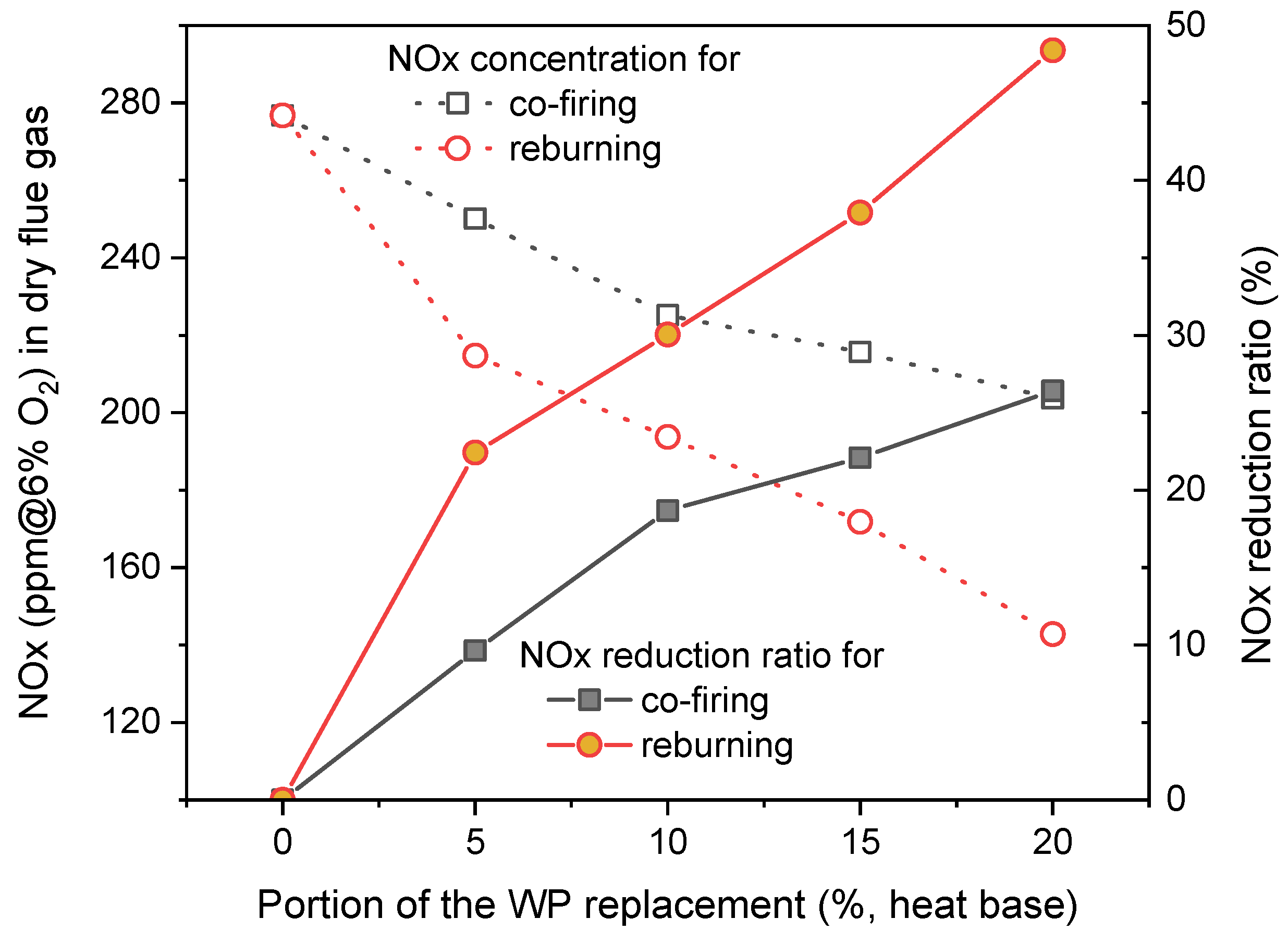
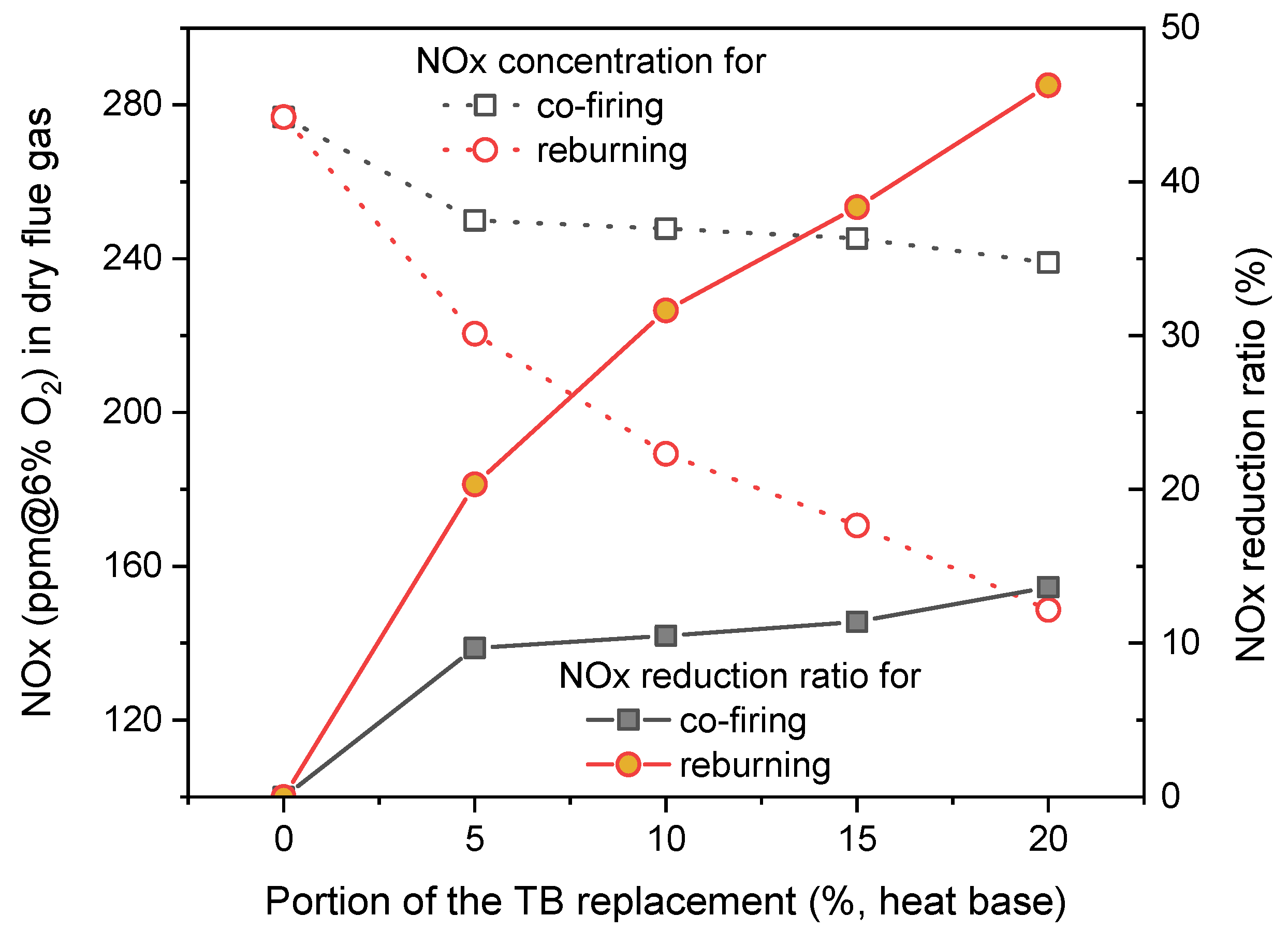
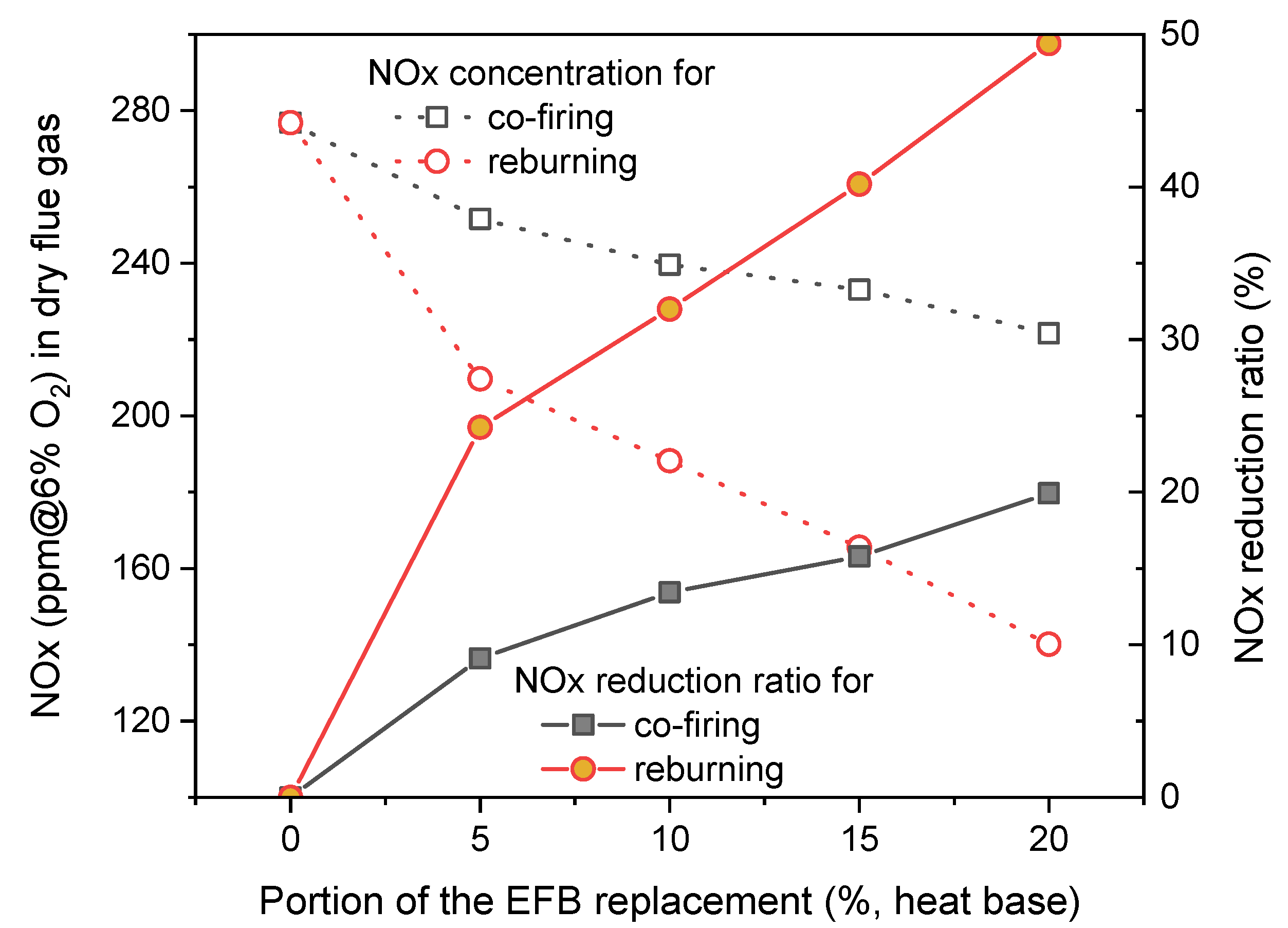
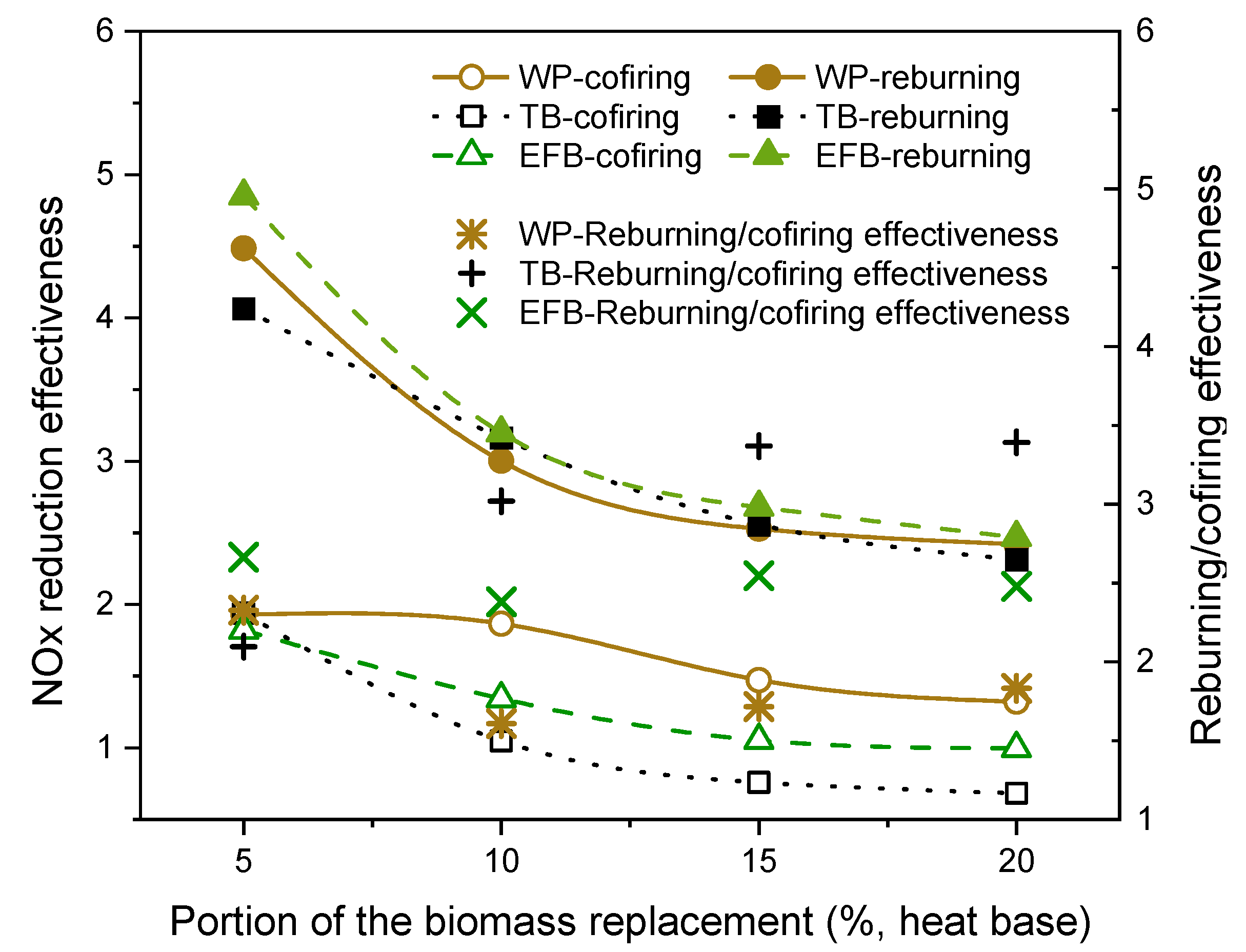
| Biomass | Firing Technology | Percent of Biomass Substitution | |||
|---|---|---|---|---|---|
| 5% | 10% | 15% | 20% | ||
| WP | Cofiring * | #1 | #2 | #3 | #4 |
| Reburning | #5 | #6 | #7 | #8 | |
| TB | Cofiring * | #9 | #10 | #11 | #12 |
| Reburning | #13 | #14 | #15 | #16 | |
| EFB | Cofiring * | #17 | #18 | #19 | #20 |
| Reburning | #21 | #22 | #23 | #24 | |
Publisher’s Note: MDPI stays neutral with regard to jurisdictional claims in published maps and institutional affiliations. |
© 2021 by the authors. Licensee MDPI, Basel, Switzerland. This article is an open access article distributed under the terms and conditions of the Creative Commons Attribution (CC BY) license (https://creativecommons.org/licenses/by/4.0/).
Share and Cite
Chae, T.; Lee, J.; Lee, Y.; Yang, W.; Ryu, C. Pilot-Scale Experimental Study on Impacts of Biomass Cofiring Methods to NOx Emission from Pulverized Coal Boilers—Part 2: NOx Reduction Capability through Reburning versus Cofiring. Energies 2021, 14, 6552. https://doi.org/10.3390/en14206552
Chae T, Lee J, Lee Y, Yang W, Ryu C. Pilot-Scale Experimental Study on Impacts of Biomass Cofiring Methods to NOx Emission from Pulverized Coal Boilers—Part 2: NOx Reduction Capability through Reburning versus Cofiring. Energies. 2021; 14(20):6552. https://doi.org/10.3390/en14206552
Chicago/Turabian StyleChae, Taeyoung, Jaewook Lee, Yongwoon Lee, Won Yang, and Changkook Ryu. 2021. "Pilot-Scale Experimental Study on Impacts of Biomass Cofiring Methods to NOx Emission from Pulverized Coal Boilers—Part 2: NOx Reduction Capability through Reburning versus Cofiring" Energies 14, no. 20: 6552. https://doi.org/10.3390/en14206552
APA StyleChae, T., Lee, J., Lee, Y., Yang, W., & Ryu, C. (2021). Pilot-Scale Experimental Study on Impacts of Biomass Cofiring Methods to NOx Emission from Pulverized Coal Boilers—Part 2: NOx Reduction Capability through Reburning versus Cofiring. Energies, 14(20), 6552. https://doi.org/10.3390/en14206552







